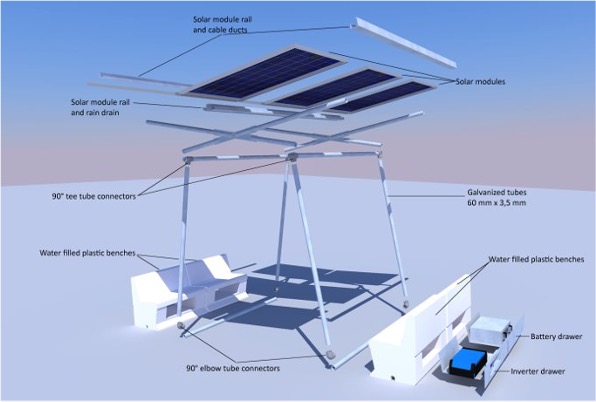From pv magazine Germany
Anyone who has visited India will know roof terraces are a common focus of residential life, a fact which hinders rooftop PV use and renders the nation's ambitious solar targets even more daunting to achieve.
To overcome the hurdle, Germany's international development agency – the Deutsche Gesellschaft für Internationale Zusammenarbeit (GIZ)– has developed a rooftop system designed for the Indian market.
The ‘PV Port & Store' system is a ready-to-use array that, according to the GIZ, can be bought, installed, and switched on within two days and takes the form of a pavilion with two benches and a solar module roof to offer shade. The benches are hollow plastic bowls filled with water and have three functions. Their water-filled weight is 1.5 tons, anchoring the system even at wind speeds of 200 kilometers per hour; the water can feed a sprinkler, for module cleaning; and it also cools a battery and hybrid inverter stowed inside the benches in drawers surrounded by water.
Designed for the Indian market, the pavilion is aimed at 100% self-consumption of the solar power generated. By means of its own dynamic energy measurement of household consumption, the inverter determines whether, and how much, valuable power should be used by the household to avoid electricity flowing to the grid. Smaller systems of that nature, which only cover household electricity demand, do not have to be registered with local energy suppliers, reducing paperwork.
Similar systems have encountered problems when the final circuit load is too high and, as a result, can cause household cabling malfunction. In such cases, the electricity fed into the house network from the roof is added to the electricity consumed, causing cables to heat. To prevent this, the inverter in the German-designed pavilion has a protection fuse and measuring sensors. Another feature of the PV Port & Store is an emergency power capability, a useful precaution, given power outages are particularly common in India. In addition, grid operators could access pavilion batteries to use any stored electricity for grid-related services.
The price of the pavilion varies depending on the size and location of each installation. A GIZ spokesperson estimated a target price for a 2 kW system with a small lead-acid battery, at around €2,500. A system with a large lithium iron phosphate battery would cost around €5,500.
The 2 kW devices will be available in five versions. For storage capacity, customers can choose between 2.4 and 4.8 kWh. Buyers can opt for lead-acid batteries, whose service life is estimated at around three years, or ten-year lithium iron phosphate devices. There is also a 1.6 kW pavilion, which does not offer energy storage.
Although such systems could be used by multiple tenants, even the model with the largest battery storage capacity would find the power generated consumed by the requirements of a single air-conditioned room.
The pavilion is manufactured by the home-pv business controlled by India's Ministry of New and Renewable Energies. With regards to manufacturing, the ministry says it has already tasked three companies with branch offices in India to roll out the systems, namely: Servotech, Kosol and Enphase.
This content is protected by copyright and may not be reused. If you want to cooperate with us and would like to reuse some of our content, please contact: editors@pv-magazine.com.




With LPG gas price hitting the roof high time Government encourage Solar power for cooking. It can be done with as little as 400 watt pamel, a grid toed inverter and one 100 volt ampere battery. Should not cost more than 20000 Rupees for a household. With LPG gas price going to touch 2000 or 3000 Rupees Solar will be a sure winner.